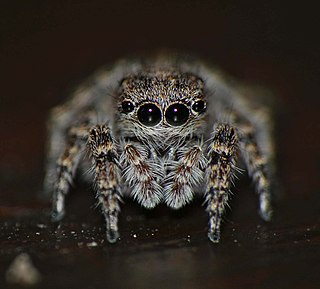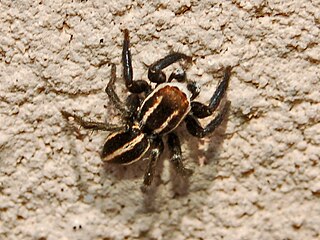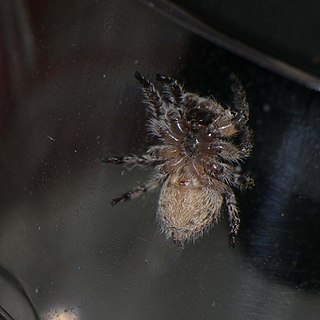
Langelurillus is a spider genus of the family Salticidae. All the described species occur only in Africa.

Phlegra is a genus of jumping spiders that was first described by Eugène Louis Simon in 1876. The name is a reference to a mythical location in both Greek and Roman mythology.

Phlegra bresnieri is a species of jumping spiders. Its specific name bresnieri honors the 19th-century French Arabist Louis-Jacques Bresnier.
Pellenes cingulatus is a jumping spider species in the genus Pellenes that lives in Tanzania. It was first described in 2000.
Tanzania minutus is a species of jumping spider in the genus Tanzania that lives in Tanzania. The male was first described in 2000 and the species was originally known as Lilliput minutus.
Tanzania mkomaziensis is a jumping spider that lives in Tanzania. It was originally known as Lilliput mkomaziensis.
Tanzania pusillus is a species of jumping spider in the genus Tanzania that lives in Tanzania. The male was first described in 2000 and the species was originally known as Lilliput pusillus.
Tusitala proxima is a jumping spider that lives in Tanzania.
Tusitala unica is a jumping spider that lives in Tanzania.
Heliophanus pygmaeus is a jumping spider that lives in Senegal, Tanzania, South Africa and Zimbabwe.

Langelurillus furcatus is a species of jumping spider in the genus Langelurillus that lives in Kenya and Tanzania. It was first described in 2000 by Wanda Wesołowska and Anthony Russell-Smith. The spider is small, with a carapace that is between 1.8 and 2.4 mm long and an abdomen between 1.7 and 2.7 mm long. The male is smaller than the female. It has a dark brown carapace, although the female is lighter, that has no markings. The female abdomen is dark russet with a pattern of black and white patches and the male abdomen is dark fawn with an indistinct light pattern. It has orange legs with dark patches, the female also having dark rings on its legs. The spider is similar to other related species, particularly Langelurillus alboguttatus, but can be distinguished by its two tibial apophysis, which make a V-shape. The epigyne has a deep depression that is plugged with a waxy secretion.

Langelurillus alboguttatus is a species of jumping spider in the genus Langelurillus that lives in Tanzania. It was first described in 2000 by Wanda Wesołowska and Anthony Russell-Smith. Only the male has been identified. The spider is small, with a carapace typically 1.7 mm (0.067 in) long and an abdomen 1.4 mm (0.055 in) long. The dark brown carapace is plain and the yellow abdomen has a single fawn stripe, while the legs are short and yellowish-orange. It is similar to other related species, particularly Langelurillus furcatus, but can be distinguished by the presence of the three tibial apophysis, or spikes, on the pedipalp.

Langelurillus rufus is a species of jumping spider in the genus Langelurillus that lives in Ethiopia, Kenya and Tanzania. The male was originally described by Roger de Lessert in 1925 and named Langona rufa while male and female samples were named Langelurillus difficilis by Wanda Wesołowska and Anthony Russell-Smith in 2000. The species were combined with the current name in 2012. The spider is small, with a brown carapace that is between 1.9 and 2.0 mm long and an abdomen between 19 and 2.4 mm long. The female can be identified by the orange patches on its carapace. The spider has an abdominal pattern that helps distinguish the species from the related Langelurillus manifestus, which has a brown design on a yellowish abdomen with a brown design while Langelurillus rufus has a yellow design on a brown abdomen.

Langelurillus manifestus is a species of jumping spider in the genus Langelurillus that lives in Tanzania. It was first described in 2000 by Wanda Wesołowska and Anthony Russell-Smith. The spider is small, with a carapace that is between 2.1 and 2.5 mm long and an abdomen between 2.0 and 2.2 mm long. The female carapace is lighter than the male and has a pattern of irregular patches, which may also be found in some examples of the female abdomen. The male abdomen is lighter and has a fawn streak down the middle. The legs are brown, the female having dark rings on its legs. It is similar to other related species, particularly Langelurillus rufus, but can be distinguished by the male's larger size and lighter coloration. The female has an oval epigyne that leads to seminal ducts that are shorter than Langelurillus rufus but longer than Langelurillus squamiger.

Langelurillus ignorabilis is a species of jumping spider in the genus Langelurillus that lives in Zimbabwe. The female was first described in 2008 by Wanda Wesołowska and Meg Cumming based on an example discovered with ten spiderlings. The male has not been identified. The spider is small with a dark brown carapace 2.7 mm (0.11 in) long and a brownish-grey abdomen 3.0 mm (0.12 in) long. It has short yellow legs. The species is similar to others in its genus and also member of the genus Langona, but differs in the design of the copulatory organs. For example, the seminal ducts are longer and have more loops than Langona bethae.

Langelurillus minutus is a species of jumping spider in the genus Langelurillus that lives in Namibia and Zimbabwe. It was first described in 2011 by Wanda Wesołowska and Meg Cumming. The spider is small, with a cephalothorax that is between 1.8 and 2.3 mm long and an abdomen between 1.5 and 3.9 mm long. The male is noticeably smaller than the female, which is reflected in the species name. The species is generally brown, but has indistinct patches on its abdomen and orange or orange-yellow legs. The male has a very convex palpal bulb and the female an epigyne with a large pocket and compact multi-chambered receptacles.
Phlegra simplex is a jumping spider species in the genus Phlegra that lives in Tanzania and Zimbabwe. The male was first described in 2000.
Phlegra varia is a jumping spider species in the genus Phlegra that lives in Tanzania. The female was first described in 2000. It is closely related to Phlegra bresnieri and Phlegra chrysops.
Phlegra pusilla is a species of jumping spider in the genus Phlegra. The male was first described in 1994 from a sample from Yemen. The female was subsequently described in 2006, and the distribution of the species identified from across Africa from Senegal to Zimbabwe and into the Arabian Peninsula. The species is identified by a characteristic pattern on the carapace and the structure of the copulatory organs.
Xuriella prima is the type species of jumping spider in the genus Xuriella first described in 2000 by Wanda Wesołowska and Anthony Russell-Smith. First discovered in Tanzania, it has also been identified in South Africa and Zimbabwe.




